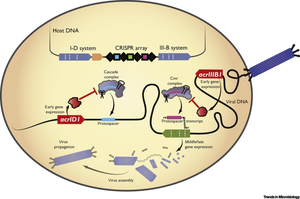Small Intestinal Bacterial Overgrowth
Overview
Small intestinal bacterial overgrowth (SIBO) is defined as the abnormal increase in the overall bacterial population in the small intestine. [1] Common symptoms of SIBO include diarrhea, flatulence, abdominal pain and bloating. [2]
SIBO was first suggested by Barker and Hummel in their 1939 publication “Macrocytic anemia in association with intestinal strictures and anastomoses.”, which provided key findings for both the study of Macrocytic anemia and the study of SIBO. [3]
Select a topic about genetics or evolution in a specific organism or ecosystem.
The topic must include one section about microbes (bacteria, viruses, fungi, or protists). This is easy because all organisms and ecosystems have microbes.
Compose a title for your page.
Type your exact title in the Search window, then press Go. The MicrobeWiki will invite you to create a new page with this title.
Open the BIOL 116 Class 2021 template page in "edit."
Copy ALL the text from the edit window.
Then go to YOUR OWN page; edit tab. PASTE into your own page, and edit.<be>
At right is a sample image insertion. It works for any image uploaded anywhere to MicrobeWiki. The insertion code consists of:
Double brackets: [[
Filename: PHIL_1181_lores.jpg
Thumbnail status: |thumb|
Pixel size: |300px|
Placement on page: |right|
Legend/credit: Electron micrograph of the Ebola Zaire virus. This was the first photo ever taken of the virus, on 10/13/1976. By Dr. F.A. Murphy, now at U.C. Davis, then at the CDC.
Closed double brackets: ]]
Other examples:
Bold
Italic
Subscript: H2O
Superscript: Fe3+
Testing for SIBO
Include some current research, with at least one image.
Sample citations: [2]
A citation code consists of a hyperlinked reference within "ref" begin and end codes.
For multiple use of the same inline citation or footnote, you can use the named references feature, choosing a name to identify the inline citation, and typing [6]
Second citation of Ref 1: [2]
Section 2 Microbiome
Include some current research, with a second image.
Conclusion
Overall text length (all text sections) should be at least 1,000 words (before counting references), with at least 2 images.
Include at least 5 references under References section.
References
- ↑ “Small Intestinal Bacterial Overgrowth (SIBO).” Mayo Clinic, Mayo Foundation for Medical Education and Research, 6 Jan. 2022, https://www.mayoclinic.org/diseases-conditions/small-intestinal-bacterial-overgrowth/symptoms-causes/syc-20370168.
- ↑ 2.0 2.1 2.2 Sachdev, Amit H, and Mark Pimentel. “Gastrointestinal bacterial overgrowth: pathogenesis and clinical significance.” Therapeutic advances in chronic disease vol. 4,5 (2013): 223-31. doi:10.1177/2040622313496126
- ↑ [Barker, W. H., and L. E. Hummel. "Macrocytic anemia in association with intestinal strictures and anastomoses." Bull Johns Hopkins Hosp 64.2 (1939): 15.]
- ↑ Bartlett et al.: Oncolytic viruses as therapeutic cancer vaccines. Molecular Cancer 2013 12:103.
- ↑ Lee G, Low RI, Amsterdam EA, Demaria AN, Huber PW, Mason DT. Hemodynamic effects of morphine and nalbuphine in acute myocardial infarction. Clinical Pharmacology & Therapeutics. 1981 May;29(5):576-81.
- ↑ 6.0 6.1 text of the citation
Edited by Yufan Lu, student of Joan Slonczewski for BIOL 116 Information in Living Systems, 2022, Kenyon College.

